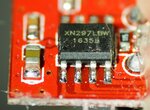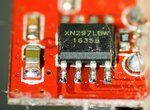DroneFisherMan
Newbie level 4

Hi All,
i am using bayangtoys X16 GPS drone.
I managed to solder the "alfa APA-M04 7 dBi gain RP-SMA directional panel antenna Wi-Fi" on the board, and it was working absolutely fine. Until, I put hot glue on the antenna's solder to make it more solid.
Since then , when I power on the remote the red light comes on for a second and beeps then it goes off. I removed the hot glue and still its doing same thing..
Have I burnt the Tx?
I have checked for any short on the antenna's ground and main wire, there is no short there. I have checked the battery and power, and all looks good.
Could anyone help me out please!
Link to video explaining the issue https://vimeo.com/290456327

i am using bayangtoys X16 GPS drone.
I managed to solder the "alfa APA-M04 7 dBi gain RP-SMA directional panel antenna Wi-Fi" on the board, and it was working absolutely fine. Until, I put hot glue on the antenna's solder to make it more solid.
Since then , when I power on the remote the red light comes on for a second and beeps then it goes off. I removed the hot glue and still its doing same thing..
Have I burnt the Tx?
I have checked for any short on the antenna's ground and main wire, there is no short there. I have checked the battery and power, and all looks good.
Could anyone help me out please!
Link to video explaining the issue https://vimeo.com/290456327

Last edited:




